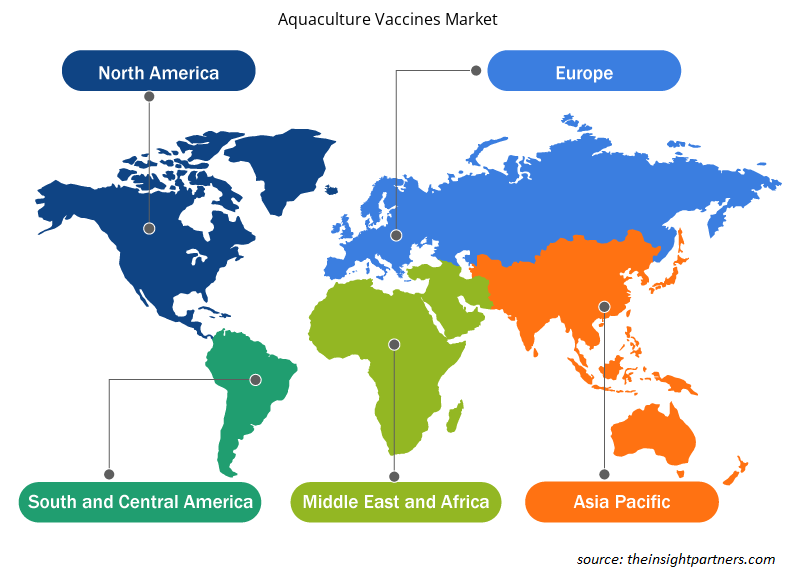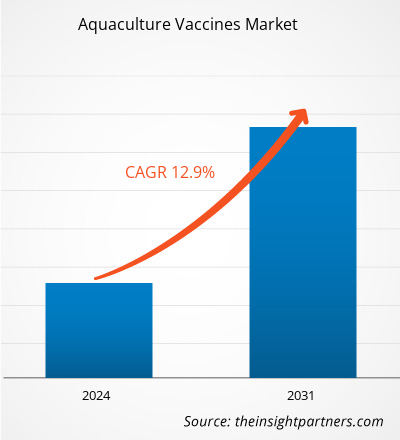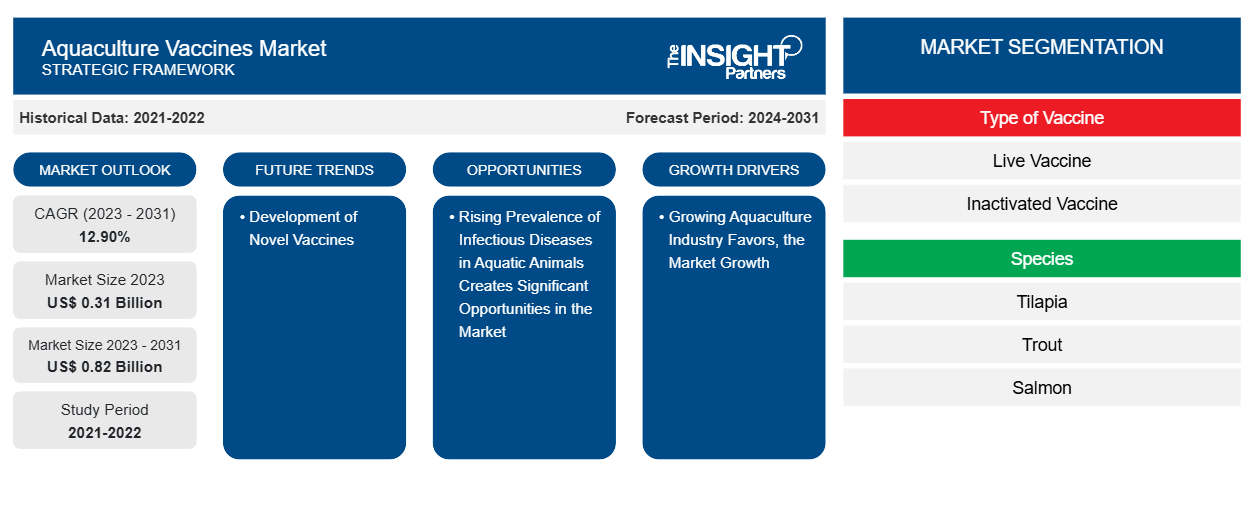Si prevede che la dimensione del mercato dei vaccini per l'acquacoltura raggiungerà 0,82 miliardi di dollari entro il 2031, rispetto agli 0,31 miliardi di dollari del 2023. Si prevede che il mercato registrerà un CAGR del 12,90% nel periodo 2023-2031. Lo sviluppo di nuovi vaccini rimarrà probabilmente una tendenza chiave nel mercato.CAGR of 12.90% during 2023–2031. The development of novel vaccines will likely remain a key trend in the market.
Analisi di mercato dei vaccini per l'acquacoltura
La necessità di vaccinazioni per curare le malattie nelle specie di acquacoltura aumenterà a causa della crescente frequenza di malattie infettive tra gli animali acquatici. Il mercato sarà inoltre supportato da maggiori iniziative degli operatori di mercato, come il lancio di nuovi prodotti, l'apertura di nuove strutture, investimenti in nuovi progetti e una collaborazione attiva con governi stranieri. Si prevede che la regione Asia-Pacifico registrerà una crescita significativa durante il periodo di previsione a causa dei principali paesi produttori di acquacoltura della regione, del boom dell'industria dell'acquacoltura e della crescente domanda dei consumatori. La necessità di vaccini per l'acquacoltura della regione aumenterà a causa di questi fattori.
Panoramica del mercato dei vaccini per l'acquacoltura
Gli allevatori utilizzano le vaccinazioni per l'acquacoltura per ottenere un'elevata redditività a causa della crescente domanda di prodotti alimentari derivati da animali acquatici, come olio, caviale, proteine in polvere e carne. Il mercato sta anche assistendo a un forte aumento della domanda di prodotti a base di carne di alta qualità, sostenibili e salutari che contengono pochi o nessun farmaco. Si consiglia vivamente di consumare pesce frequentemente come parte di una dieta equilibrata. I pesci possono produrre più proteine utilizzando il loro tasso di alimentazione inferiore poiché hanno un contenuto proteico più elevato rispetto alla carne di animali terrestri e un tasso di conversione alimentare (FCR) inferiore rispetto agli animali terrestri.
Inoltre, le proteine del pesce sono povere di aminoacidi essenziali e altamente digeribili rispetto alle proteine di origine animale. Mangiare pesce e molluschi può ridurre il rischio di artrite, infiammazione e malattie cardiache. Il pesce è considerato benefico per la salute principalmente perché contiene acidi grassi polinsaturi (PUFA) omega 3 (n-3) a catena lunga. Inoltre, le proteine del pesce contengono un gran numero di peptidi bioattivi. Se questi vengono assunti nelle giuste quantità e sono biodisponibili per gli esseri umani, possono avere molti effetti rispettabili sulla salute. L'inibizione dell'enzima del sistema renina-angiotensina-aldosterone (RAAS) è responsabile del controllo della pressione sanguigna. Altri benefici per la salute includono il controllo dell'infiammazione da parte dei peptidi antiossidanti, il mantenimento della salute delle ossa, i benefici per la salute mentale derivanti dai peptidi inibitori del fattore di attivazione piastrinica acetil-idrolasi (PAF-AH) e dai peptidi oppioidi e diverse altre bioattività. Pertanto, c'è una crescente necessità di vaccini per l'acquacoltura a causa della necessità di un allevamento sano di animali acquatici.
Personalizza questo report in base alle tue esigenze
Riceverai la personalizzazione gratuita di qualsiasi report, comprese parti di questo report, o analisi a livello nazionale, pacchetto dati Excel, oltre a usufruire di grandi offerte e sconti per start-up e università
-
Scopri le principali tendenze di mercato in questo rapporto.Questo campione GRATUITO includerà analisi di dati che spaziano dalle tendenze di mercato alle stime e alle previsioni.
Driver e opportunità del mercato dei vaccini per l'acquacoltura
La crescita dell'industria dell'acquacoltura favorisce la crescita del mercato
L'Organizzazione delle Nazioni Unite per l'alimentazione e l'agricoltura ha pubblicato un rapporto intitolato "The State of World Fisheries and Aquaculture" nel 2022. Il rapporto afferma che il numero di alimenti acquatici consumati a livello globale, escluse le alghe, è aumentato di oltre cinque volte rispetto a quasi 60 anni fa. La quantità di alimenti acquatici consumati in tutto il mondo è cresciuta da 28 milioni di tonnellate nel 1961 a circa 158 milioni nel 2019. Dal 1961 in poi, il tasso di crescita medio annuo del consumo è stato del 3,0%, mentre il tasso di crescita della popolazione è stato dell'1,6%. L'aumento del reddito, il cambiamento delle preferenze dei consumatori e l'espansione dell'offerta contribuiscono a un aumento del consumo pro capite. Il consumo pro capite di alimenti acquatici in 227 paesi è stato previsto dall'Organizzazione delle Nazioni Unite per l'alimentazione e l'agricoltura nel 2019. In termini di popolazione, nel 2019, le nazioni con un consumo globale medio inferiore costituivano il 54% della popolazione mondiale. Con oltre 80 kg di cibo acquatico consumato annualmente a persona, Islanda, Isole Faroe e Maldive hanno il più alto consumo di cibo acquatico. Il consumo medio globale pro capite nel 2019 era di 20,5 kg. Al contrario, il peso medio nei paesi ad alto reddito era di 26,5 kg, mentre nei paesi a basso reddito era di 5,4 kg.
L'industria dell'acquacoltura si sta espandendo più velocemente del previsto a causa della crescente domanda di animali. I vaccini per l'acquacoltura riducono il rischio di infezione e aumentano la resa del prodotto. Di conseguenza, il mercato dei vaccini per l'acquacoltura sta crescendo a causa dell'espansione del settore dell'acquacoltura.
La crescente prevalenza di malattie infettive negli animali acquatici crea notevoli opportunità di mercato
Secondo lo studio di ricerca della National Library of Medicine (NLM) "Prevalenza dei nematodi anisakidi nei pesci in Cina: una revisione sistematica e una meta-analisi", pubblicato a febbraio 2022, i nematodi anisakidi erano comuni nei pesci in tutta la Cina, con un tasso di incidenza complessivo del 45,5%. La percentuale di incidenza più elevata è stata riscontrata nel pesce fresco (58,1%). I nematodi anisakidi erano più diffusi nella Cina orientale (55,3%), con il Mar Cinese Orientale che presentava la prevalenza più elevata (76,8%). I dati della rivista Aquaculture Research & Development indicano che dal 2014 al 2018 sono stati segnalati circa 219 casi di malattie infettive nel settore dell'acquacoltura fresca. Di questi, l'1,83% era virale, il 74,88% era parassitario, il 12,80% era batterico e il 10,50% dei casi era costituito da malattie batteriche e parassitarie combinate. Di conseguenza, si prevede che l'elevata incidenza di malattie infettive aumenterà la domanda di vaccini, aprendo in futuro opportunità redditizie per il mercato dei vaccini per l'acquacoltura.NLM) research study "Prevalence of Anisakid Nematodes in Fish in China: A Systematic Review and Meta-Analysis," which was released in February 2022, anisakid nematodes were common in fish throughout China, with a pooled incidence rate of 45.5%. The highest occurrence percentage was found in fresh fish (58.1%). Anisakid nematodes were most prevalent in Eastern China (55.3%), with the East China Sea having the highest prevalence (76.8%). Data from the Aquaculture Research & Development journal indicates that from 2014 to 2018, approximately 219 cases of infectious diseases were reported in the fresh aquaculture industry. Of these, 1.83% were viral, 74.88% were parasitic, 12.80% were bacterial, and 10.50% of cases combined bacterial and parasitic illnesses. Consequently, it is anticipated that the high incidence of infectious diseases will increase demand for vaccinations, opening up profitable opportunities for the aquaculture vaccines market in the future.
Analisi della segmentazione del rapporto di mercato sui vaccini per l'acquacoltura
I segmenti chiave che hanno contribuito alla derivazione dell'analisi di mercato dei vaccini per l'acquacoltura sono il tipo di vaccino, la specie e la via di somministrazione.
- In base al tipo di vaccino, il mercato dei vaccini per l'acquacoltura è segmentato in vaccino vivo, vaccino inattivato e altri. Il segmento dei vaccini inattivati ha detenuto la quota di mercato più significativa nel 2023.
- Per specie, il mercato è categorizzato in tilapia, trota, salmone, gamberetti e altri. Il segmento della trota ha detenuto la quota maggiore del mercato nel 2023.
- In base alla via di somministrazione, il mercato è segmentato in vaccini iniettabili, vaccini per immersione e vaccini orali. Il segmento dei vaccini iniettabili ha detenuto la quota significativa del mercato nel 2023.
Analisi della quota di mercato dei vaccini per l'acquacoltura per area geografica
L'ambito geografico del rapporto sul mercato dei vaccini per l'acquacoltura è suddiviso principalmente in cinque regioni: Nord America, Asia Pacifico, Europa, Medio Oriente e Africa, Sud e Centro America.
Stati Uniti, Canada e Messico costituiscono i tre segmenti del mercato nordamericano dei vaccini per l'acquacoltura. Gli Stati Uniti detengono la quota maggiore del mercato nordamericano dei vaccini per l'acquacoltura. I principali motori della crescita del mercato sono l'elevata incidenza di malattie infettive nel settore dell'acquacoltura, l'aumento dei livelli di produzione e il crescente sviluppo e introduzione di nuovi vaccini per l'acquacoltura. Gli Stati Uniti hanno prodotto 5,2 milioni di tonnellate di pesce nel 2018, per un valore di 7063,5 milioni di dollari USA, secondo The OECD Review of Fisheries 2020. Il 17% proveniva dall'acquacoltura e l'83% dalla pesca. Mentre il suo valore è aumentato del 29%, la quantità di produzione è aumentata del 7% tra il 2008 e il 2018.
Inoltre, gli operatori di mercato hanno accelerato la produzione di prodotti tecnologicamente sviluppati nel paese. Ad esempio, a settembre 2020, Virbac ha acquisito una gamma di vaccini per la tilapia da Ictyogroup, un'azienda di salute animale specializzata in biologia di ricerca e sviluppo. Il gruppo Virbac ha ricevuto i diritti per la distribuzione e la commercializzazione di vaccini registrati e autogeni in tutto il mondo. Oltre all'acquisizione, come accennato in precedenza, le due aziende hanno stretto una partnership per lo sviluppo da parte di Ictyogroup di nuove formulazioni e nuovi vaccini, sempre per la divisione Aqua Virbac, la tilapia e le aziende nel mercato dell'acquacoltura. L'accordo prevede anche il trasferimento da Ictyogroup a Virbac di diversi dipendenti specializzati nel supporto tecnico di marketing e biologia di ricerca e sviluppo. Pertanto, i crescenti sviluppi da parte di vari operatori di mercato nel settore dell'acquacoltura statunitense e i fattori di cui sopra stimoleranno il mercato dei vaccini per l'acquacoltura negli Stati Uniti.
Approfondimenti regionali sul mercato dei vaccini per l'acquacoltura
Le tendenze regionali e i fattori che influenzano il mercato dei vaccini per l'acquacoltura durante il periodo di previsione sono stati ampiamente spiegati dagli analisti di Insight Partners. Questa sezione discute anche i segmenti e la geografia del mercato dei vaccini per l'acquacoltura in Nord America, Europa, Asia Pacifico, Medio Oriente e Africa e America meridionale e centrale.

- Ottieni i dati specifici regionali per il mercato dei vaccini per l'acquacoltura
Ambito del rapporto di mercato sui vaccini per l'acquacoltura
| Attributo del report | Dettagli |
|---|---|
| Dimensioni del mercato nel 2023 | 0,31 miliardi di dollari USA |
| Dimensioni del mercato entro il 2031 | 0,82 miliardi di dollari USA |
| CAGR globale (2023-2031) | 12,90% |
| Dati storici | 2021-2022 |
| Periodo di previsione | 2024-2031 |
| Segmenti coperti |
Per tipo di vaccino
|
| Regioni e Paesi coperti |
America del Nord
|
| Leader di mercato e profili aziendali chiave |
|
Densità degli attori del mercato dei vaccini per l'acquacoltura: comprendere il suo impatto sulle dinamiche aziendali
Il mercato dei vaccini per l'acquacoltura sta crescendo rapidamente, spinto dalla crescente domanda degli utenti finali dovuta a fattori quali l'evoluzione delle preferenze dei consumatori, i progressi tecnologici e una maggiore consapevolezza dei benefici del prodotto. Con l'aumento della domanda, le aziende stanno ampliando le loro offerte, innovando per soddisfare le esigenze dei consumatori e capitalizzando sulle tendenze emergenti, il che alimenta ulteriormente la crescita del mercato.
La densità degli operatori di mercato si riferisce alla distribuzione di aziende o società che operano in un particolare mercato o settore. Indica quanti concorrenti (operatori di mercato) sono presenti in un dato spazio di mercato in relazione alle sue dimensioni o al valore di mercato totale.
Le principali aziende che operano nel mercato dei vaccini per l'acquacoltura sono:
- Tattiche acquatiche Salute dei pesci
- HIPRA SA
- Merck & Co Inc.
- Microsynbiotix Ltd
- Immunologici indiani Ltd
- Nisseiken Co Ltd
Disclaimer : le aziende elencate sopra non sono classificate secondo un ordine particolare.

- Ottieni una panoramica dei principali attori del mercato dei vaccini per l'acquacoltura
Notizie di mercato e sviluppi recenti sui vaccini per l'acquacoltura
Il mercato dei vaccini per l'acquacoltura viene valutato raccogliendo dati qualitativi e quantitativi post-ricerca primaria e secondaria, che includono importanti pubblicazioni aziendali, dati associativi e database. Di seguito sono elencati alcuni degli sviluppi nel mercato dei vaccini per l'acquacoltura:
- Merck Animal Health, nota come MSD Animal Health al di fuori degli Stati Uniti e del Canada, una divisione di Merck & Co., Inc., ha annunciato di aver firmato un accordo definitivo per acquisire l'attività di acquacoltura di Elanco Animal Health Incorporated per 1,3 miliardi di dollari USA in contanti, consistente in un portafoglio innovativo di medicinali e vaccini, nutrizione e integratori per specie acquatiche; due stabilimenti di produzione di acquacoltura correlati in Canada e Vietnam; nonché un centro di ricerca in Cile. Si prevede che l'acquisizione sarà completata entro la metà del 2024, subordinatamente alle approvazioni delle autorità di regolamentazione e ad altre consuete condizioni di chiusura. (Fonte: Merck Animal Health, comunicato stampa, febbraio 2024)
Copertura e risultati del rapporto sul mercato dei vaccini per l'acquacoltura
Il rapporto "Dimensioni e previsioni del mercato dei vaccini per l'acquacoltura (2021-2031)" fornisce un'analisi dettagliata del mercato che copre le seguenti aree:
- Dimensioni e previsioni del mercato dei vaccini per l'acquacoltura a livello globale, regionale e nazionale per tutti i principali segmenti di mercato coperti dall'ambito
- Tendenze del mercato dei vaccini per l'acquacoltura e dinamiche di mercato come fattori trainanti, limitazioni e opportunità chiave
- Analisi dettagliata delle cinque forze PEST/Porter e SWOT
- Analisi di mercato dei vaccini per l'acquacoltura che copre le principali tendenze del mercato, il quadro globale e regionale, i principali attori, le normative e i recenti sviluppi del mercato.
- Analisi del panorama industriale e della concorrenza che copre la concentrazione del mercato, l'analisi della mappa di calore, i principali attori e gli sviluppi recenti per il mercato dei vaccini per l'acquacoltura
- Profili aziendali dettagliati
- Analisi storica (2 anni), anno base, previsione (7 anni) con CAGR
- Analisi PEST e SWOT
- Valore/volume delle dimensioni del mercato - Globale, Regionale, Nazionale
- Industria e panorama competitivo
- Set di dati Excel
Report recenti
Testimonianze
Motivo dell'acquisto
- Processo decisionale informato
- Comprensione delle dinamiche di mercato
- Analisi competitiva
- Analisi dei clienti
- Previsioni di mercato
- Mitigazione del rischio
- Pianificazione strategica
- Giustificazione degli investimenti
- Identificazione dei mercati emergenti
- Miglioramento delle strategie di marketing
- Aumento dell'efficienza operativa
- Allineamento alle tendenze normative























 Ottieni un campione gratuito per - Mercato dei vaccini per l'acquacoltura
Ottieni un campione gratuito per - Mercato dei vaccini per l'acquacoltura